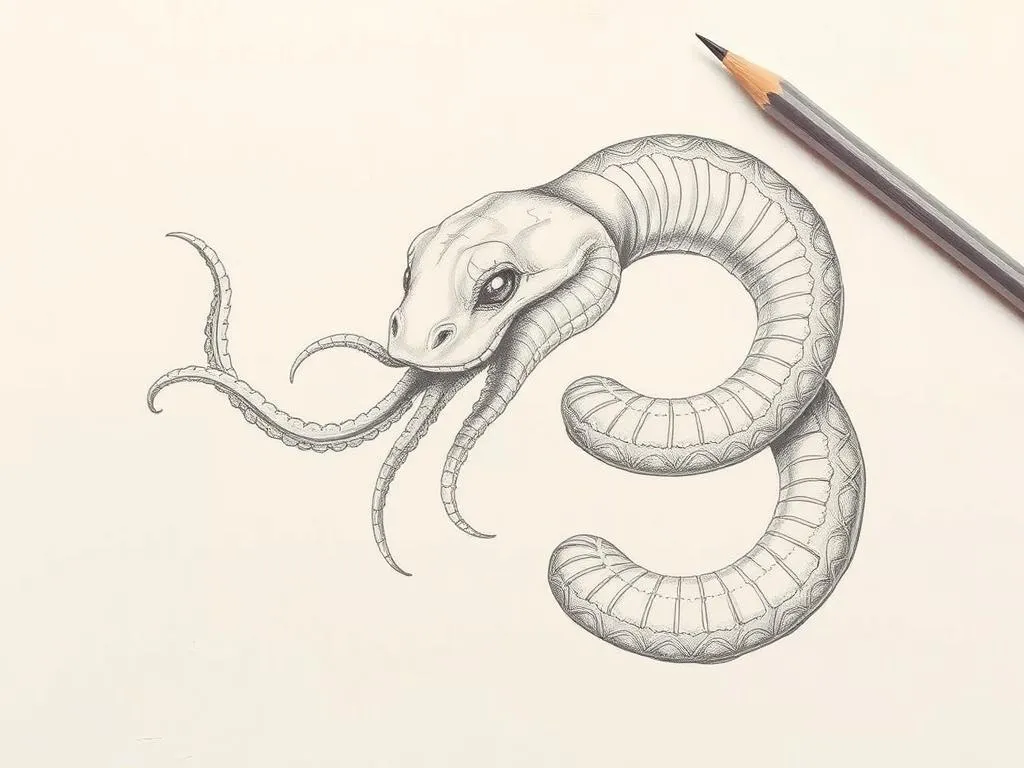Unraveling the Mystique of the Tentacled Snake: Symbolism and Significance

Disclaimer: Some images on this website are AI-generated artworks and may not accurately represent real animals.
The tentacled snake is a unique species that has captured the imagination of many due to its striking appearance and intriguing behaviors. This article delves into the multifaceted nature of the tentacled snake, exploring its biological characteristics, behavioral traits, and cultural significance. Furthermore, we will examine the rich symbolism and meaning associated with this remarkable creature, including its representations in dreams, modern interpretations, and environmental symbolism.
Understanding the Tentacled Snake
Overview of the Species
The tentacled snake, scientifically known as Erpeton tentaculatum, is a fascinating aquatic species native to the waters of Southeast Asia. This snake is most commonly found in freshwater habitats, such as rivers and swamps, where it thrives in the warm, murky waters of its environment.
Physical Characteristics
| Characteristic | Description |
|---|---|
| Length | Up to 1 meter |
| Coloration | Olive green to brown |
| Unique Features | Long, tentacle-like extensions near the eyes |
| Habitat | Freshwater rivers and swamps |
| Diet | Primarily fish |
The tentacled snake’s unique tentacle-like structures are not just for show; they serve a purpose. These appendages assist the snake in sensing its surroundings, allowing it to detect vibrations in the water and locate prey effectively. The snake’s coloration provides excellent camouflage among aquatic plants, making it a skilled predator.
Behavioral Traits
The tentacled snake exhibits several fascinating behavioral traits that contribute to its survival.
-
Hunting Methods: This species employs a unique ambush technique when hunting. It remains motionless, often partially submerged, waiting for unsuspecting fish to come within striking distance. Once the opportunity arises, it strikes with precision, utilizing its sharp teeth to capture prey.
-
Adaptations: The tentacled snake has adapted to its aquatic environment in remarkable ways. Its flattened body allows it to glide effortlessly through the water, while its specialized nostrils positioned on the top of its head enable it to breathe without exposing much of its body.
-
Social Interactions: Tentacled snakes are generally solitary creatures but can sometimes be observed basking together in the sun. Their interactions are primarily limited to mating and territorial disputes.
Cultural Significance
Throughout history, the tentacled snake has held a notable place in various cultural narratives and folklore. In some regions, it is viewed as a symbol of cunning and adaptability, reflecting the snake’s ability to thrive in challenging environments.
In certain indigenous cultures, the tentacled snake is associated with water spirits and is often featured in myths and legends that highlight its mystical qualities. Its presence in folklore serves as a reminder of the deep connection between nature and human spirituality.

Symbolism & Spiritual Meaning
The tentacled snake is rich in symbolism, embodying themes of transformation, balance, and emotional depth. Understanding these symbolic meanings can provide valuable insights into personal growth and self-awareness.
Transformation and Adaptation
One of the primary symbols associated with the tentacled snake is transformation. This snake represents the ability to adapt and change in response to one’s environment. Much like the snake itself, which camouflages and adjusts its hunting strategies, individuals can learn to embrace change and navigate life’s challenges.
- Personal Growth: The tentacled snake encourages individuals to embrace their own transformations, reminding them that change is a natural part of life.
Balance of Power
The tentacled snake embodies the duality of strength and vulnerability. Its unique physical attributes allow it to be both a fierce predator and a creature that must remain vigilant against larger threats.
- Inner Strength: The symbolism of balance serves as a reminder that one can exhibit strength while also being aware of their vulnerabilities. This balance is crucial for personal empowerment and resilience.
Connection to Water
Water is often associated with emotions, intuition, and fluidity. The tentacled snake, being an aquatic creature, symbolizes the ability to navigate the depths of one’s emotional landscape.
- Emotional Awareness: The snake encourages individuals to explore their feelings and instincts, promoting a deeper understanding of oneself.
Tentacled Snake in Dreams
Dreams involving the tentacled snake can hold significant meaning, often reflecting the dreamer’s subconscious thoughts and feelings.
Common Dream Scenarios
| Dream Scenario | Interpretation |
|---|---|
| Seeing a tentacled snake | Facing fears or confronting change |
| Being chased by a snake | Feeling overwhelmed or vulnerable |
| Catching a snake | Achieving personal goals or success |
Emotional Resonance
The presence of a tentacled snake in a dream may indicate that the dreamer is grappling with feelings of vulnerability or transformation. It can symbolize a period of change and the need to adapt to new circumstances.
Cultural Dream Interpretations
Different cultures offer varying interpretations of snakes in dreams. In some traditions, snakes are seen as omens of change or transformation, while in others, they may represent hidden fears or challenges. The tentacled snake’s unique characteristics can add depth to these interpretations, emphasizing the importance of adaptability and emotional resilience.
Modern Interpretations
In contemporary society, the tentacled snake continues to inspire and influence various fields, from environmental activism to art and literature.
Environmental Symbolism
The tentacled snake serves as a powerful symbol of environmental issues and the need for conservation. As its habitat faces threats from pollution and climate change, the snake symbolizes the fragility of aquatic ecosystems.
- Awareness and Action: Its presence can inspire individuals to engage in conservation efforts and raise awareness about the importance of protecting natural habitats.
Art and Literature
The tentacled snake has made its mark in modern storytelling, often featured as a symbol of mystery and transformation. Artists and writers draw upon its unique characteristics to explore themes of adaptability and the interplay between nature and humanity.
- Narrative Depth: In literature, the tentacled snake can represent the struggles of characters facing change and the journey towards self-discovery.
Pop Culture References
In pop culture, the tentacled snake has appeared in various forms of media, from movies to video games. Its striking appearance and symbolic significance make it a captivating subject for creators.
- Inspiration: Whether as a villain or a mysterious ally, the tentacled snake continues to intrigue audiences, reflecting our fascination with nature’s wonders.
Key Takeaways
The symbolism and meaning of the tentacled snake encompass a wide array of themes that resonate with personal and collective experiences. Here are the key takeaways:
- Transformation: Embrace change as an opportunity for growth.
- Balance: Recognize the interplay of strength and vulnerability within oneself.
- Emotional Exploration: Allow yourself to navigate your emotional landscape with awareness.
- Environmental Awareness: Understand the importance of protecting our natural ecosystems.
- Cultural Reflection: Explore the diverse interpretations of the tentacled snake across cultures.
Conclusion
The tentacled snake serves as a powerful symbol of transformation, balance, and emotional depth. Its unique characteristics and the rich cultural narratives surrounding it remind us of the profound connections between nature and our personal journeys. By exploring the symbolism of the tentacled snake, individuals can gain valuable insights into their own lives and the world around them. Embracing these themes can lead to personal growth, greater awareness, and a deeper appreciation for the natural world.







